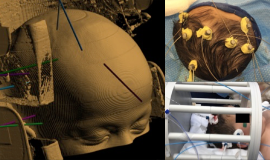Early Outcomes of Stereoelectroencephalography Followed by MR-Guided Laser Interstitial Thermal Therapy: A Paradigm for Minimally Invasive Epilepsy Surgery
Abstract number :
2.319
Submission category :
9. Surgery / 9B. Pediatrics
Year :
2018
Submission ID :
490059
Source :
www.aesnet.org
Presentation date :
12/2/2018 4:04:48 PM
Published date :
Nov 5, 2018, 18:00 PM
Authors :
Islam Fayed, Georgetown University Medical Center; Kelsey Cobourn, Children's National Medical Center; Shannon Sullivan, Children's National Medical Center; Robert Keating, Children's National Medical Center; and Chima Oluigbo, Children's National Medical
Rationale: Stereotactic electroencephalography (sEEG) and magnetic resonance guided laser interstitial thermal therapy (MRgLITT) have both emerged as minimally invasive alternatives to open surgery for the localization and treatment of medically refractory lesional epilepsy. Although some data is available about the use of these procedures individually, it is almost non-existent on their use in conjunction. Our aim is to report early outcomes regarding efficacy and safety of sEEG followed by MRgLITT for localization and ablation of seizure foci in the pediatric population of medically refractory lesional epilepsy. Methods: A single-center retrospective review was performed to identify pediatric patients who underwent sEEG followed by MRgLITT procedures between January and September 2017. Demographic, intraoperative, and outcome data were compiled and analyzed. Results: Four pediatric patients with nine total lesions underwent sEEG followed by MRgLITT procedures between January and September 2017. Mean age at surgery was 10.75 (2-21) years. Surgical substrates included two patients with tuberous sclerosis and two patients with focal cortical dysplasia. Methods of stereotaxis consisted of BrainLab Varioguide and ROSA robotic guidance, with successful localization of seizure foci in all cases. sEEG procedure length averaged 153 (67-235) minutes, with a mean of 6 (4-8) electrodes and 56 (18-84) contacts per patient. MRgLITT was guided by BrainLab, ClearPoint, or ROSA, with an average procedure length of 223 (179-252) minutes. Mean duration of monitoring was 5.75 (4-8) days, and mean total hospital stay was 8 (5-11) days. Over a mean follow-up duration of 6.6 (4.6-10.2) months, three patients were seizure free (Engel I, 75%), while one patient saw significant improvement in seizure frequency (Engel II, 25%). There were no complications. Conclusions: This early data demonstrates that sEEG followed by MRgLITT can safely and effectively localize and ablate epileptogenic foci in a minimally invasive paradigm for the treatment of medically refractory lesional epilepsy in pediatric populations. Continued collection of data with extended follow-up is needed. Funding: No funding was received in support of this abstract.

.tmb-.png?Culture=en&sfvrsn=3f4f0264_0)